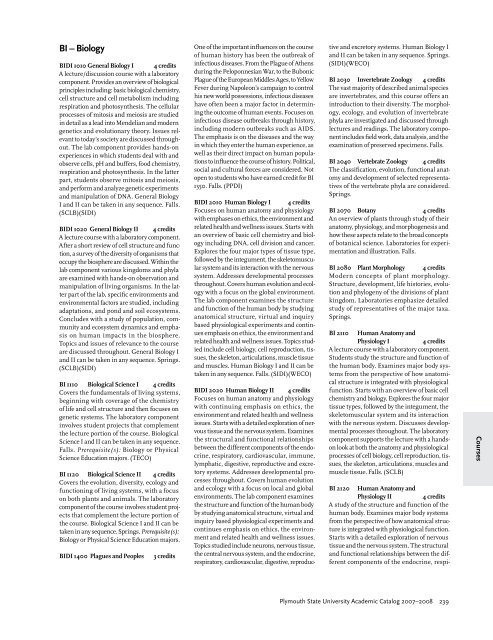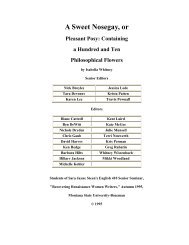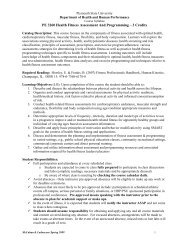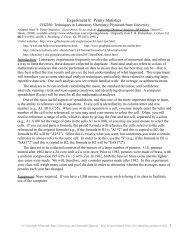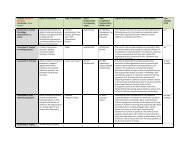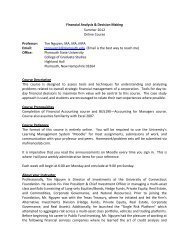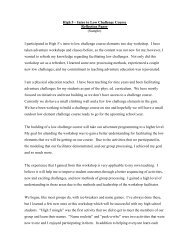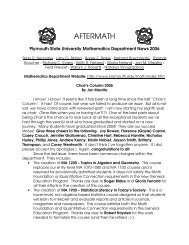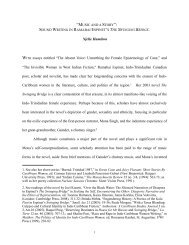2007-2008 Undergraduate Academic Catalog - Plymouth State ...
2007-2008 Undergraduate Academic Catalog - Plymouth State ...
2007-2008 Undergraduate Academic Catalog - Plymouth State ...
- No tags were found...
Create successful ePaper yourself
Turn your PDF publications into a flip-book with our unique Google optimized e-Paper software.
BI – BiologyBIDI 1010 General Biology I 4 creditsA lecture/discussion course with a laboratorycomponent. Provides an overview of biologicalprinciples including: basic biological chemistry,cell structure and cell metabolism includingrespiration and photosynthesis. The cellularprocesses of mitosis and meiosis are studiedin detail as a lead into Mendelian and moderngenetics and evolutionary theory. Issues relevantto today’s society are discussed throughout.The lab component provides hands-onexperiences in which students deal with andobserve cells, pH and buffers, food chemistry,respiration and photosynthesis. In the latterpart, students observe mitosis and meiosis,and perform and analyze genetic experimentsand manipulation of DNA. General BiologyI and II can be taken in any sequence. Falls.(SCLB)(SIDI)BIDI 1020 General Biology II 4 creditsA lecture course with a laboratory component.After a short review of cell structure and function,a survey of the diversity of organisms thatoccupy the biosphere are discussed. Within thelab component various kingdoms and phylaare examined with hands-on observation andmanipulation of living organisms. In the latterpart of the lab, specific environments andenvironmental factors are studied, includingadaptations, and pond and soil ecosystems.Concludes with a study of population, communityand ecosystem dynamics and emphasison human impacts in the biosphere.Topics and issues of relevance to the courseare discussed throughout. General Biology Iand II can be taken in any sequence. Springs.(SCLB)(SIDI)BI 1110 Biological Science I 4 creditsCovers the fundamentals of living systems,beginning with coverage of the chemistryof life and cell structure and then focuses ongenetic systems. The laboratory componentinvolves student projects that complementthe lecture portion of the course. BiologicalScience I and II can be taken in any sequence.Falls. Prerequisite(s): Biology or PhysicalScience Education majors. (TECO)BI 1120 Biological Science II 4 creditsCovers the evolution, diversity, ecology andfunctioning of living systems, with a focuson both plants and animals. The laboratorycomponent of the course involves student projectsthat complement the lecture portion ofthe course. Biological Science I and II can betaken in any sequence. Springs. Prerequisite(s):Biology or Physical Science Education majors.BIDI 1400 Plagues and Peoples3 creditsOne of the important influences on the courseof human history has been the outbreak ofinfectious diseases. From the Plague of Athensduring the Peloponnesian War, to the BubonicPlague of the European Middles Ages, to YellowFever during Napoleon’s campaign to controlhis new world possessions, infectious diseaseshave often been a major factor in determiningthe outcome of human events. Focuses oninfectious disease outbreaks through history,including modern outbreaks such as AIDS.The emphasis is on the diseases and the wayin which they enter the human experience, aswell as their direct impact on human populationsto influence the course of history. Political,social and cultural forces are considered. Notopen to students who have earned credit for BI1350. Falls. (PPDI)BIDI 2010 Human Biology I 4 creditsFocuses on human anatomy and physiologywith emphases on ethics, the environment andrelated health and wellness issues. Starts withan overview of basic cell chemistry and biologyincluding DNA, cell division and cancer.Explores the four major types of tissue type,followed by the integument, the skeletomuscularsystem and its interaction with the nervoussystem. Addresses developmental processesthroughout. Covers human evolution and ecologywith a focus on the global environment.The lab component examines the structureand function of the human body by studyinganatomical structure, virtual and inquirybased physiological experiments and continuesemphasis on ethics, the environment andrelated health and wellness issues. Topics studiedinclude cell biology, cell reproduction, tissues,the skeleton, articulations, muscle tissueand muscles. Human Biology I and II can betaken in any sequence. Falls. (SIDI)(WECO)BIDI 2020 Human Biology II 4 creditsFocuses on human anatomy and physiologywith continuing emphasis on ethics, theenvironment and related health and wellnessissues. Starts with a detailed exploration of nervoustissue and the nervous system. Examinesthe structural and functional relationshipsbetween the different components of the endocrine,respiratory, cardiovascular, immune,lymphatic, digestive, reproductive and excretorysystems. Addresses developmental processesthroughout. Covers human evolutionand ecology with a focus on local and globalenvironments. The lab component examinesthe structure and function of the human bodyby studying anatomical structure, virtual andinquiry based physiological experiments andcontinues emphasis on ethics, the environmentand related health and wellness issues.Topics studied include neurons, nervous tissue,the central nervous system, and the endocrine,respiratory, cardiovascular, digestive, reproductiveand excretory systems. Human Biology Iand II can be taken in any sequence. Springs.(SIDI)(WECO)BI 2030 Invertebrate Zoology 4 creditsThe vast majority of described animal speciesare invertebrates, and this course offers anintroduction to their diversity. The morphology,ecology, and evolution of invertebratephyla are investigated and discussed throughlectures and readings. The laboratory componentincludes field work, data analysis, and theexamination of preserved specimens. Falls.BI 2040 Vertebrate Zoology 4 creditsThe classification, evolution, functional anatomyand development of selected representativesof the vertebrate phyla are considered.Springs.BI 2070 Botany4 creditsAn overview of plants through study of theiranatomy, physiology, and morphogenesis andhow these aspects relate to the broad conceptsof botanical science. Laboratories for experimentationand illustration. Falls.BI 2080 Plant Morphology 4 creditsModern concepts of plant morphology.Structure, development, life histories, evolutionand phylogeny of the divisions of plantkingdom. Laboratories emphasize detailedstudy of representatives of the major taxa.Springs.BI 2110 Human Anatomy andPhysiology I4 creditsA lecture course with a laboratory component.Students study the structure and function ofthe human body. Examines major body systemsfrom the perspective of how anatomicalstructure is integrated with physiologicalfunction. Starts with an overview of basic cellchemistry and biology. Explores the four majortissue types, followed by the integument, theskeletomuscular system and its interactionwith the nervous system. Discusses developmentalprocesses throughout. The laboratorycomponent supports the lecture with a handsonlook at both the anatomy and physiologicalprocesses of cell biology, cell reproduction, tissues,the skeleton, articulations, muscles andmuscle tissue. Falls. (SCLB)BI 2120 Human Anatomy andPhysiology II 4 creditsA study of the structure and function of thehuman body. Examines major body systemsfrom the perspective of how anatomical structureis integrated with physiological function.Starts with a detailed exploration of nervoustissue and the nervous system. The structuraland functional relationships between the differentcomponents of the endocrine, respi-Courses<strong>Plymouth</strong> <strong>State</strong> University <strong>Academic</strong> <strong>Catalog</strong> <strong>2007</strong>–<strong>2008</strong> 239


